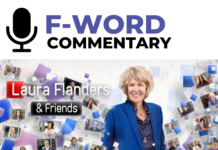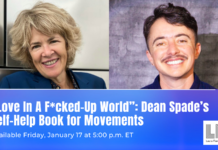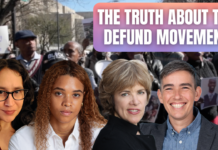Big Oil, Gas and mining companies are in the backyards of many Americans — but did you know that some of the same extractive corporations are also operating around the world? Colombia, the Philippines, Mexico, and the Standing Rock Reservation — ”resource colonization”, as today’s guest puts it, is a worldwide issue. But how often do we get the global picture? In the documentary “Powerlands”, director Ivey-Camille Manybeads Tso meets Indigenous communities across three continents and speaking seven languages, to explore the global resistance against corporations such as Peabody Coal and BHP Petroleum. In the film, she discovers that their struggles are connected; is what she’s tracing a trans-local and trans-generational Indigenous movement that is building? Our guests say Indigenous resistance across national borders can beat back corporate assaults on nature, people and our climate. Joining Laura for this Indigenous Peoples’ Day special are Ivey-Camille Manybeads Tso and Kim Smith, both from the Diné (Navajo) Nation. Manybeads Tso is a self-described queer director and Smith is a community organizer who appears in the film. Plus a commentary from Laura on the Amazon monopoly — it takes one individual to hoard power, and many people to topple them down.
“Standing Rock showed us what is to come, especially when you look at the police state, the military force and imperialism in this country . . . You’re seeing it all over the world, have all of this heavy machinery to take and kill what they see is in their path.” – Kim Smith
“We’re seeing this huge transcontinental movement that is forming in Oaxaca with wind power . . . The win that happened last October in Colombia, requiring mining corporations to clean up after themselves, that’s huge for every place on the planet who is currently affected by mining . . .” Ivey-Camille Manybeads Tso
THE LAURA FLANDERS SHOW
“POWERLANDS”: INDIGENOUS YOUTH FIGHT BIG OIL & GAS WORLDWIDE
LAURA FLANDERS: Seven languages, three continents, the film “Powerlands” is not your usual documentary. In it, Director Ivey-Camille Manybeads Tso travels from her home in the Southwest of the US to Colombia, the Philippines, Mexico, and the Standing Rock Reservation to meet Indigenous people up against big extractive corporations. The communities she visits are all deeply connected to their local specific places and people and cultures. They’re linked too in that they’re being ravaged by some of the very same corporations with names like, well, among them, Peabody Coal and BHP Petroleum. “Powerlands” paints a picture of places in struggle that are building power in parallel with one another. Is what she’s tracing a sort of trans-local and trans-generational Indigenous movement that is building across the continents? And can it succeed against the most powerful corporations on earth? According to the Intergovernmental Panel on Climate Change’s latest and last report, 21st century humans must either transform or burn up, so do the people of the “Powerlands” have lessons to teach us all? Seven years ago, “The Laura Flanders Show” aired a report based on some of the early footage gathered for “Powerlands.” Today I’m excited to welcome to the program Ivey-Camille Manybeads Tso, the director, and Kim Smith, one of the organizers who appears in the film. They are both back with the finished product that is already winning awards. Ivey-Camille is a self-described queer Navajo filmmaker. Kim Smith is a community organizer. They are both members of the Diné or Navajo Nation. “Powerlands” produced by our former producer, Jordan Flaherty, along with Ewa Jasiewicz, with Emily Faye Ratner, with music by Daniel French is available for streaming through Fuse now. Well, to kick things off, here is the beginning of the documentary “Powerlands” where Ivey-Camille Manybeads Tso introduces us to the journey she’s about to take.
: My family can trace our history to 85 generations with this land. I began working on this film to document our community’s struggle against resource colonization. Along the way, I found that we are not alone. This is a story of Indigenous people protecting and rebuilding. Multinational corporations like Glencore, Peabody, and BHP have been extracting hundreds of billions of dollars in profit. It is happening in nearly every country on earth. First came colonization, now corporations are stealing the resources from under our feet. This extraction is global but so is our resistance.
: Water is life!
: Water for our children!
: From Dinetah, I connected with Indigenous people in Colombia, the Philippines, and Mexico who are uniting to protect the earth. We are appealing to public opinion, changing laws, and putting our bodies on the line. This film is part of that resistance.
LAURA FLANDERS: Kim, Ivey-Camille, welcome to the program. Congratulations on the film. What a journey the film has been on since we last saw any glimpse of it, and what a journey you’ve been on, Ivey-Camille. Let’s start with you. Did I read right that you started this film when you were 19 years old? What set you off on your project?
IVEY-CAMILLE MANYBEADS TSO: Yeah, so we started at 19 and actually Jordan and I met in Flagstaff, Arizona. He had just come back from Colombia and mutual friends had put us in contact and we were talking about the differences and similarities between Black Mesa and Colombia. And I’m from Black Mesa, it’s where I was born, raised, so the conversation really began rolling. And we found that there were more similarities than there were differences, from the food to the clothing to even the same corporation was affecting both of these communities, and that’s really where it really began. And at first, we started to look, should we follow the corporation, do we follow an emotional journey, what do we go with, and then we reached out to like 20 different communities all over.
LAURA FLANDERS: The industries you’re up against have shaped your lives. Your subjects, your colleagues in the documentary talk poignantly about what they’re up against. But if, Kim, you were to tell your story of how coal has affected you, what would you say?
KIM SMITH: I come from, on the Arizona side, St. Michaels, Arizona and then on the New Mexico side, from Iyanbito, New Mexico and really it is a part of the huge hub of extractive industries that power the Southwest. Three miles east of me is one of the biggest open pit coal mines and then two miles to the south of me is El Paso gas line, which, you know, connects the Permian Basin to the greater Southwest region. And, you know, this has really just affected my life tremendously, first of all, through health impacts. I have an autoimmune disease that, you know, is known to come from extractive industries. There is cancer and different diseases from the extractive industry and my family and in my community. And so aside from that, there is a lot of policy both within the national level, regional level, and tribal level that is really pushing to continue those extractive industries to be powered by our nation and by our resources.
LAURA FLANDERS: And what about you, Ivey-Camille, in what ways is this a personal story for you around coal?
IVEY-CAMILLE MANYBEADS TSO: Yeah, so I’m from Black Mesa. That’s where my mom and dad met. My grandmother, May Tso, has been fighting this resistance since the beginning. I’m from the HPL side, the Hopi Partitioned Lands side, in that before the 1960s, it was NPL, Navajo Partitioned Lands, and so my entire life, I’ve seen my entire family get forcibly relocated off of this region, you know, losing their house, their cattle, and friends and family throughout everything, as well as seeing the health impacts that happen all across the board. But also growing up, you know, having a white side and growing up in town in Flagstaff, I also see the long-term effects that this polluting can do not just in these communities. You know, we are seeing how the depletion of the water from the aquifer underneath, how it’s affecting the entire Southwest region through fires and floods, and all of this is just going to have long-term effects on the land and on people.
KIM SMITH: Our people are really still dealing with the cancer rates, with the contaminated water, with the contaminated soil, with people living in radiating homes and schools, you know, so there’s all of these things that are underlying.
LAURA FLANDERS: Now these petition lines that you talked about, for people that don’t know, what were they, what are they, and how did they change the landscape?
IVEY-CAMILLE MANYBEADS TSO: Yeah, so in the early 1950s when the starts were talking between the federal government mining coalitions and the Navajo and Hopi Nations, the Navajo Nations said no and the Hopi Nations said yes. So they went in and on top of, if you took like a res map and you took a mineral map and lay them on top of each other, you would see where the coal seam was, where the reservation line was redrawn along the coal seam, and that was given towards Hopi Partitioned Lands, and it was a way to separate and isolate two sister tribes.
KIM SMITH: We are considered a national sacrifice zone, like by the federal government. And so what that means is it opens up industry to come in and do their exploratory drilling to do all of these things. And so that partly is why there has been the largest uranium spill in this nation and on Diné land.
LAURA FLANDERS: Your film, it seems to me has the agenda of bringing people together if not physically, at least in the same film, to connect people, to show the connections that exist across borderlands, across cultures, languages, you name it. Seven languages in the film, wow. Is that part of the motivation or was there a sort of family prompt to do the work that you do, Ivey-Camille?
IVEY-CAMILLE MANYBEADS TSO: So I was raised in with the idea of k’e, which is this Navajo word that means relationships, being all around us, being all of us. And there’s even this thing K’emmunity that people are working with right now, because the best or the simplest translation is relationship that embodies so much more. But it’s that thing that we all have with each other and with the air and with the plants around us and with the water around us and to know that if anything’s going to happen, it has to be done in solidarity.
LAURA FLANDERS: So that’s partly what makes your film so important, Ivey-Camille. But if you could explain a little bit why you decide to tell more than just the Black Mesa story, and I don’t mean to say just, it’s a huge story, but from there, you travel all across the continent and to the Philippines, why?
IVEY-CAMILLE MANYBEADS TSO: Talking to Jordan about Colombia, that’s really when it was like, “Oh my God, where else is this happening?” And it turned out that it’s happening everywhere. It’s happening across England, it’s happening across Ireland, it’s happening across Canada and Mexico and South America and North America and every single continent, every single place on earth, there’s some form of extraction that is happening. And so in that beginning, and that’s really where it went down to was one, not to, like educate those who already know to remind them that we are still here, to remind each other that we are still here and we all support each other, and if you are in solidarity, if you are fighting, we are currently still here together and we still honor you in support, but also to ask people what can you do in your own backyard?
LAURA FLANDERS: Was it just coincidence that everywhere you went, women seem to be in leadership of these resistance struggles?
IVEY-CAMILLE MANYBEADS TSO: Yeah, yeah, that was it. And honestly, it happens way more frequently. Navajo is a matriarchal society. I always grew up with the women commanding the room and I never questioned it. And it wasn’t really until other people started watching the film that they were like, “Hey, there’s like a lot of women,” and I was like, “Oh, I guess you’re right, yep.” That’s just how it was. And community isn’t, you know, like a gendered thing. It is about who is willing to put themselves out there, who is fighting for someone, and a lot of times that often comes and starts with mothers or grandmothers or aunties as I am for few, you know? And so that’s really where it come from is from love and from caring and for wanting something better for somebody else.
LAURA FLANDERS: How does your work as an organizer across generations intersect with this work of the movie?
KIM SMITH: After the film, I did a lot of visiting of Indigenous resistance camps. I went to Unist’ot’en, Layla Island. That’s what led me to Standing Rock, the Buffalo Field Campaign, the RNC, you know, all of these different places, resistance camps and helping in the kitchen. You know, I do a lot of food work and food really is like such medicine for the soul, and a lot of times when you’re on the front lines, you don’t really have a good meal. This really led me to understand and study, maybe not study but really see how other resistance movements are, what they’re resisting, how they’re resisting and really see the intersects and then really compare it to my own community and how we’re trying to defend the land. There’s a huge lack of infrastructure in our communities and housing is one of them. There’s a huge housing crisis and it came to the point where it’s like, “Why am I going to all of these places when I don’t really have a roof over my head?” And so from that, it started this process of like, “How do I move home? What does that look like?” and then it goes into the policy of the relationship between the federal government and my people. The first step was really looking at what types of toxins are in the soil. We’ve cleaned up about five acres of illegal landfills in the area that were building sustainable structures.
LAURA FLANDERS: Were there things that surprised you, that you learned from the film around people doing similar sorts of resistance in Mexico, the Philippines, Colombia?
IVEY-CAMILLE MANYBEADS TSO: Yeah, I definitely think it’s one of the movements that has really happened. There’s been this huge push for decolonization. I like to use the word reindigenize because decolonization means to take or, you know, lose something at this point. We saw it in Oaxaca with their community work that they were doing. I mean, part of their way of resistance was literally just pulling trees into the road to like help block cars. And that was really amazing and really beautiful to see, to see them rallying around the sandbars. Seeing it in the Philippines, they’re using it with their plants and their medicines and they’re bringing everyone back to care for these plants that have been in this area for generations and generations and to see that same work going on across the world.
LAURA FLANDERS: We’re going to go to a trailer now for the film “Powerlands.” In this part, the mobilization against the Dakota Access Pipeline is heating up on the Standing Rock Reservation. Kim Smith is there along with LaDonna Brave Bull Allard, who was a matriarch of the water protector movement and was very active in that place at that time.
: They’re trying to say we don’t exist. We are Indigenous people to this land. We have the roots growing right out of our feet. We belong here.
: It’s not just our community that’s affected this way. There’s so many Indigenous communities, there’s so many people of color that have to face these realities every day.
: We are not separate from our environment and we have been damaged in this whole process of being colonized.
: We show up to actions with just ourselves, with our prayers, with our voices, and that’s power. Now, that’s the power that makes them shiver in their little SWAT gear.
: You put our backs against the wall, we put one foot in front of the other and we face the storm like our brothers, the Buffalo. We face the star. We are not backing down ever again.
LAURA FLANDERS: Standing Rock did change things, though, for the movement and also on the ground. Kim, you were one of the first people, I think, there in that mobilization, setting up that kitchen that you referred to. How do you assess the difference that the Standing Rock mobilization and the reaction to it made both there in the Dakotas and where you are?
KIM SMITH: Well, Standing Rock really showed us what is to come, especially when you look at the police state, the military force, imperialism in this country. And, you know, not only did we learn a lot but the police state learned a lot about what our resistance looks like. And quite frankly, they have a billion dollar budget and we don’t have that kind of budget. And so it’s really eye-opening and you’re seeing it all over the world that, you know, the militarization in the police state have all of this heavy machinery to take and kill what they see is in their past or in their path. One thing that we understand is that a lot of our comrades are now caught up in the prison system. If you are in the front lines, you are now considered an eco-terrorist, and so they’re really coming down hard on us. And so it is really important, as Ivey-Camille had mentioned, for us to really be home and look at what, how are we going to defend our homelands, what does that look like.
LAURA FLANDERS: You mentioned money and that put me in mind of the Biden administration’s announced Green Transition Funds. And we should say that there’s been a lot of change come to your homelands there at the Dinetah in that I think it’s three of the big plants have closed, coal fired plants feeding the Southwest there are closing at least. There is this money being announced. Will you, will Indigenous organizers, activists, the community be seeing any of that?
KIM SMITH: No, we won’t. We won’t there. So the process to get any type of federal grants, it’s like a whole, it’s not accessible to our people. And yeah, we’re seeing some of the money through our roads and things like that but nothing when it comes to healthcare, nothing when it comes to like any type of cleanup, especially when it comes to like, let’s say, the San Juan Generating Station, the Navajo Generating Station. These are power plants that have closed and some of the work that we do is making sure that these states are including Indigenous peoples in the negotiations but also making sure that there are reparations that go to our communities on our terms, not our government’s terms, not the federal government’s terms or the state’s terms. And a huge part of the funding isn’t going to health when our health is heavily impacted for generations.
LAURA FLANDERS: Coming to you, Ivey-Camille, you have said in your discussion of “Powerlands,” which screened during Climate Week in New York and is getting awards and winning acclaim, you’ve said that it is a kind of how-to guide in some ways. That being the case, what would you lift up as tactics that have emerged during your research that you think are particularly interesting or potentially fruitful?
IVEY-CAMILLE MANYBEADS TSO: So many different types. Again, community organization as we see in Oaxaca, there’s also the, you know, more radical violent side that we saw in the Philippines with NPA, New Peoples’ Army, which brings up the question, is it more violent to not pick up arms when you are being threatened with violence at all times? And so, then we also see peaceful protest through Standing Rock and we see community work in Black Mesa. I think there’s so many different types. And actually while on tour, I found my favorite type ever which was in this tiny, it’s a small town in northern England called Preston, England, and several years ago, they were about to get hit with a whole bunch of fracking, and there’s a bunch of fault lines that go through, so it caused earthquakes. So all of these women who were in their 60s and 70s and 80s and 90s dressed themselves up to look as old as possible and would go to the fracking sites and stay in a circle and knit themselves together. And then when the police showed up to remove them, they’d be like, “Oh no, we seem to have knit ourselves together. We’re just old women,” but they would call the journalists ahead of time. So then the journalists would show up and be like, “Oh my god, police attack knitting Nanas,” and it was incredible. They wound up getting a fracking ban put into place, which recently got overturned and they’re back at it. When we are either not shutting up enough that they can’t ignore us anymore or if we just go and do it ourselves, we see how incredible any of these systems can be. When we do not follow the rules, rules get changed.
KIM SMITH: Our hope is to be able to encourage people to move home and live sustainably as our ancestors did, because if we’re not moving home, then it’s easier for industries to come in and exploit the land. There’s much power in numbers. We can really change the policies if we have the power of numbers back home.
LAURA FLANDERS: Are the movements that you wrote about or rather that you reported on, seeing themselves in relation to one another in real life or only in your film? And are any of those divisions inside Navajo Nation itself, well, there in the Southwest, being mended?
IVEY-CAMILLE MANYBEADS TSO: A lot of these communities do not have running water, do not have electricity, don’t have wifi, so they’re not getting the same resources of being updated on Facebook or Instagram or TikTok about what’s happening around the world. A lot of the times, their news sources are very limited or, quite frankly, propaganda in one way. And so in a way, most of these communities are very isolated and did not know about each other. And every time that we spread and we talk about it and more and more people are getting access to cell phones and to these ways in which communication can grow, we’re seeing this huge, like transcontinental movement that is forming, you know. In Oaxaca, with wind power, we are seeing that the community wind farms are now working with organizations in Spain around community wind farms, and that’s incredible. We are seeing this become a larger movement. The win that happened last October in Colombia in their court system that was going towards requiring mining corporations to clean up after themselves, that’s huge for every place on the planet who is currently affected by mining, because mining corporations are not required to clean up after themselves, which is insane. That gigantic pipeline that we see in the film in Black Mesa will be there forever. Like it’s not something that’s going away unless there’s a call that is answered by these corporations and we’re putting the call out and more and more people are picking up.
LAURA FLANDERS: I learned constantly from the people I talk to on this program, and I’m learning from you today. Thank you both. It’s just a pleasure to have you with us.
KIM SMITH: Thank you.
IVEY-CAMILLE MANYBEADS TSO: Thanks for having us. Although, Kim, you’re the best person to talk to.
LAURA FLANDERS: No single business has done more to persuade us that greed is good and more is mighty and big as best of all than the Amazon Corporation, so it’s exciting to see Joe Biden’s appointment to head the Federal Trade Commission, Lina Khan, come forward with her long-awaited suit against that company. Is Lina Khan the Ida Tarbell of our era? Ida Tarbell being the investigative journalist who pursued Standard Oil until that monopoly was broken up through the application of the Antitrust Sherman Act in 1906. Lina Khan just may be. She’s had Amazon in her sight since the start of her career. But before we go too far down this road of telling an anti-monopoly story by allowing one individual to monopolize it, let’s remember that change takes heroic individuals for sure but it takes many and many years and many others. In this case, 17 state attorneys general are joining in the FTC’s case. Great. And the pressure for it has been built by years of work by local nonprofit organizations and advocacy groups like the Institute for Local Self-Reliance, whose Stacy Mitchell and her colleagues have been after Amazon for years, exposing their abuses of their workers and their competitors in the public sphere. Can we tell an anti-monopoly story by remembering that change is made by the many? I think we can, and we try to do that here on this program. So if you want the full uncut conversation from every week’s show, subscribe to our free podcast. And if you want the free offerings of all that we do here, including web exclusives and audio extras and we have some exciting ones coming up, you can get more information about all of those at our website. Till the next time, stay kind, stay curious. For “The Laura Flanders Show,” I’m Laura. Thanks for joining me.
For more on this episode and other forward-thinking content, subscribe to our free newsletter for updates, my commentaries, and our full uncut conversations. We also have a podcast. It’s all at lauraflanders.org.
• Indigenous Women are Showing us How to Fight for Environmental and Human Rights, by V (formerly Eve Ensler), The Guardian, Read Here
• Not All Tribes Agree With Drilling Ban Around New Mexico, by Alice Fordham, Morning Edition, NPR Read / Listen
“La Sarina” by Daniel French’s band, Las Cafeteras. French is also the music director for the documentary Powerlands. Listen & Learn More
The Laura Flanders Show is committed to making our programming, website and social media as accessible as possible to everyone, including those with visual, hearing, cognitive and motor impairments. We’re constantly working towards improving the accessibility of our content to ensure we provide equal access to all. If you would like to request accessibility-related assistance, report any accessibility problems, or request any information in accessible alternative formats, please contact us.
















